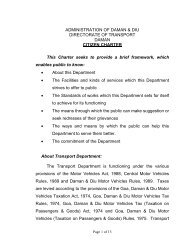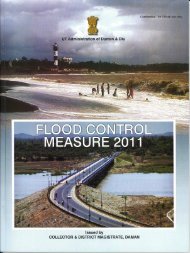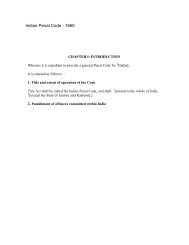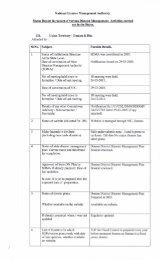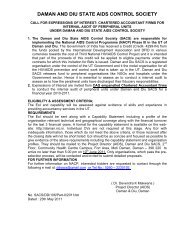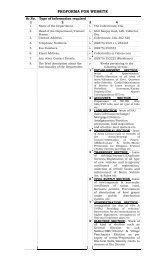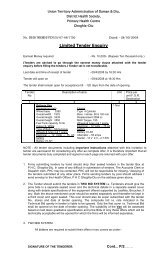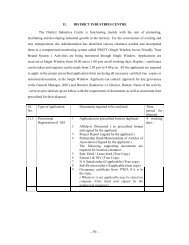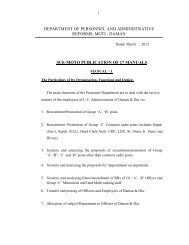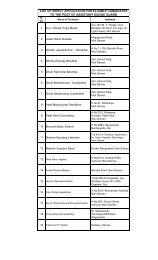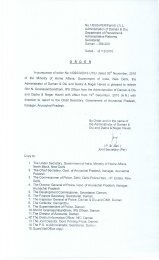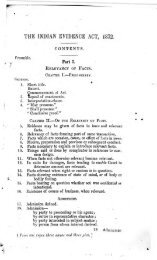bullet proof helmet and bullet proof jacket - Police Department ...
bullet proof helmet and bullet proof jacket - Police Department ...
bullet proof helmet and bullet proof jacket - Police Department ...
You also want an ePaper? Increase the reach of your titles
YUMPU automatically turns print PDFs into web optimized ePapers that Google loves.
(v)(vi)(vii)(viii)(ix)(x)The tenderer should be an authorized distributor / dealer for the tendered item <strong>and</strong> heshould furnish current year valid Authorization Letter / Dealerships certificatesfrom the Original Equipment Manufacturer (OEM). The Authorization letter shouldbe specific for the tendered item. Xerox copy of Authorization letter should beattested with valid dates. The name of item should be clearly mentioned inAuthorization Letter. (Original authorization letter should be submitted forverification at the time of commercial bid opening).The tenderer should obtain a letter from the manufacturer that the Model quoted inthe tender conforms to the specifications of the products manufactured as on date<strong>and</strong> latest. Also the product should not be of old model <strong>and</strong> service be provided forthe period as mentioned in the specifications, or up to 03 years whichever is higherfrom the date of acceptance of stores /date of installation. Also a letter showing thathe is an authorized distributor/ dealer for a minimum period of next 3 years.Power of Attorney in favour of person signing the bids to be given in Technicalenvelope (if applicable)Product Brochure clearly mentioning the features, Make/Model No. etc. If Brochureis not available then Photograph of tendered product should be submitted.Latest Test Report along with letter of the tenderer giving technical specifications tothe laboratory asking for latest report i.e. On or after December 2012, of thetendered item should be submitted.Tenderer should submit Comparative chart in the following format for each item.Sr. No.Specification of tendereditemSpecification of itemoffered by the tenderer* Special / Additional feature should be mentioned below this comparative chart.(xi) List of clients to whom the tenderer has supplied the tendered item mentioning thequantity <strong>and</strong> date of supply. Copies of supply orders should be uploaded without disclosingcommercial details.(6) The Dy. Inspector General of <strong>Police</strong>, Daman, reserves the right to select any vendor on thegrounds of his experience, the clients, the capacity or turnover of the vendor which caninfuse confidence that selected vendor can complete the work within given time.(7) The tenderer who qualifies in technical bid will have to submit the sample of the tendereditem for testing/demonstration/ field trials, before a committee of officials selected by
Operational Characteristics / Specification of Bullet Proof Helmet(Ballistic) for the Ground troops.Ergonomy: it should be possible to wear, adjust <strong>and</strong> remove the <strong>helmet</strong> with easeeven with gloved h<strong>and</strong>s. It should be provided with a three point chin strap withcotton chin cup.Shape: The <strong>helmet</strong> should adequately cover the neck <strong>and</strong> ears of the wearer <strong>and</strong> itsdesign should be on the lines of the UD Personal Armour System Ground Troops(PASGT). The shape of the <strong>helmet</strong> should facilitate the use of h<strong>and</strong> sets of in- servicecommunication equipment. Helmet should desirably have provision to mount adisplay system, h<strong>and</strong>s free communication equipment <strong>and</strong> fix electro- optical devicesas <strong>and</strong> when required.Surface finish <strong>and</strong> Camouflage: The proposed <strong>helmet</strong> should be crinkle matt finish,in the following colours:-(a) Disruptive IA pattern(b) Khakhi/ S<strong>and</strong>(c) Olive Green(d) WhiteProtection: The ballistic <strong>helmet</strong> should be able to defeat 9mm Carbine from 20m.The deformation in the <strong>helmet</strong> should not exceed 13mm, the min gap necessarybetween the harness <strong>and</strong> inner surface of the <strong>helmet</strong>.Climatic Condition: the <strong>helmet</strong> must with st<strong>and</strong> respected <strong>and</strong> sustained exposure toclimatic conditions as under:-(a) Temperature - -50 C + 50 C(b) Relative Humidity- upto +80%Use of Optical Instruments: the design of the <strong>helmet</strong> should be such that it shouldnot obstruct the use of binoculars (day <strong>and</strong> night), optical sights fitted on theweapons, range finders <strong>and</strong> artillery optical instruments like director etc.Compatibility: - the design of the <strong>helmet</strong> should preferably be compatible to wearalong with respirators <strong>and</strong> chemical hoods. This may be considered as a desirablefeature for subsequent improvement <strong>and</strong> development.Comfort: - the <strong>helmet</strong> should not cause any undue discomfort even after prolongedwearing by an individual for more than six to eight hours.Ability to absorb IR Radiation : - it is desirable that the <strong>helmet</strong> should be able toabsorb 60 to 100 percent of IR radiations from an active IR source <strong>and</strong> should notreflect any such radiations.
SPECIFICATION FOR BULLET PROOF JACKETSDESIGN PARAMETERS FOR BP JACKETSA. Shall conform to NIJ St<strong>and</strong>ard of Ballistic Resistance of Personal Body Armour (NIJSt<strong>and</strong>ard – 0101.04 updated revision ‘A’ & ‘B’) Protection against all of thefollowing weapons:(i) 9x19 mm cartridge fired through Sub Machine Gun (Such as StenMachine, MP5, Carbine, any other variant) from a distance of 5 metersto achieve a muzzle velocity 430 ± 15 m/s <strong>and</strong> the weight of the <strong>bullet</strong>between 7.4 gm to 8.2 gm.(ii) 7.62x51 mm cartridge NATO ball ammunitions fired through 7.62mmSLR/Bolt action rifle from a distance of 10 meters to achieve a muzzlevelocity 838m/s ± 15 m/s <strong>and</strong> the weight of the <strong>bullet</strong> 9.4g to 9.6g.(iii) 7.62x39 mm (mild steel core <strong>bullet</strong>) cartridge fired through AK seriesrifles from a distance of 10 meters to achieve a muzzle velocity 715 m/s ±15 m/s <strong>and</strong> the weight of the <strong>bullet</strong> 7.45g to 8.05g.B. Vest should have the components mentioned in para D below. Each componentshould be made of multi layers of same material. Each layer will be in single piece<strong>and</strong> of equal shape <strong>and</strong> size to maintain uniform thickness all over area up to edgelevel.C. SIZES OF SOFT ARMOUR PANEL (SAP): STANDARD AND LARGE.D. AREAS OF COMPONENTS OF SOFT ARMOUR PANELCoverage area of the soft armour panel as per the sizes will be as under:S. No. PANEL STANDARDSIZE(Sq. Mtr.)LARGESIZE(Sq. Mtr.)1 FRONT 0.15 0.182 BACK 0.24 0.263 COLLAR (TOTAL) 0.06 0.064 SHOULDER (TOTAL) 0.04 0.045 GROIN 0.06 0.06TOTAL 0.55 0.60However, drawings of the various components of BP <strong>jacket</strong> are enclosed asappendix-‘A’ for guidance purpose in respect of its dimensions.(i) Negative tolerance in terms of area measurement is not permissible.(ii) Measurements will be made with the help of scaled drawing on graphpaper <strong>and</strong> using planimeter.E. WEIGHT OF THE JACKETTotal weight of BP Jacket including HAPs, SAPs, trauma pads <strong>and</strong> outer carriershould not exceed as mentioned below:-(i) St<strong>and</strong>ard size - 6.31 kg(ii) Large size - 6.62 kgF. Size of Hard Armour Panel –305mm X 254mmNegative tolerance in dimensions of HAP is not permissible.
G. Shall consist of an outer carrier, removable Soft Armour Panels (SAP) of aramidfiber/suitable material <strong>and</strong> Hard armour panel (HAP) made of High PerformancePolyethylene.H. BP JACKET - CONSTRUCTION:(i) It should be in the form of <strong>jacket</strong> to provide protection against 9mm <strong>bullet</strong>(Threat level IIIA of NIJ). It should not restrict overall vertical movement of theneck of the wearer.(ii) It should have provision to accommodate two HAP plates in front <strong>and</strong> back asper dimensions specified in tender documents. Shall be lightweight <strong>and</strong>comfortable providing optimum mobility <strong>and</strong> speed.(iii)Adjustable at the shoulders, waist <strong>and</strong> groin with appropriate fasteners(Velcro’s). An adjustable nylon belt of minimum 10 cm width should beprovided with double locking of <strong>jacket</strong> with velcro.(iv)The vendor has to declare the type of materials, number of layers <strong>and</strong> their aerialdensity in technical bid of tender <strong>and</strong> they have to maintain the same in bulksupply.(v) SAP should be encased in polyurethane coated materials so as to make it water<strong>proof</strong>.(vi)(vii)(viii)(ix)(x)(xi)(xii)VELCRO FASTENERSAll the clothing flaps of the <strong>jacket</strong>s should have high quality velcro fasteners, sothat it can be worn <strong>and</strong> taken off easily/quickly. The quality <strong>and</strong> report of Velcroincluding shears strength <strong>and</strong> peel strength should be as per Bureau of IndianSt<strong>and</strong>ards specification IS: 8156-1994. The IS: 8156-1994 may be available inthe office of Bureau of Indian St<strong>and</strong>ards. Vendors will submit test reports onVelcro from any NABL accredited lab or DMSRD (MoD), Kanpur.POCKET WITH FLAPSThe <strong>jacket</strong> should be provided with two external pockets in outer carrier to housetwo magazines of 5.56mm LMG in each pocket. Two pockets should also beprovided to accommodate one grenade (HE 36) in each pocket. The size ofeach magazine is 19 cm X 7.6cm X 3.5cm <strong>and</strong> size of HE 36 grenade is 110 mmX 65 mm.BELT/KAMARBANDHAn additional belt of nylon/polyester weaving with minimum width of 10 cmshould be provided around the waist to properly secure the B.P. <strong>jacket</strong>s with thebody of the wearer around waist, so that weight of <strong>jacket</strong> is distributed onwaist/shoulders. Kamarb<strong>and</strong>h should be of same material as outer carrier withvelcro.Two pouches (one each on front <strong>and</strong> rear of outer carrier) should be provided toaccommodate two 305 mm x 254 mm Hard Armour Plates so that <strong>jacket</strong> protectsvital organs of body.Ballistic panels (SAPs & HAPs) shall be removable from outer carrier.Outer carrier shall be machine washableTRAUMA PAD FOR TRAUMA ATTENUATION(a) Trauma pad must be provided behind the SAPs, so that it remains to bodysurface to provide proper cushioning.(b) It must cover uniformly up to edge level of the SAPs.(c) Back face Signature (BFS) should not exceed 25 mm in plasticine block at30± 2.9 degree centigrade temperature of plasticine.(d) Drop test will be carried out as per NIJ st<strong>and</strong>ards.
I. MATERIALS The outer carrier shall be made of high tenacity, heavy duty, aBPasion Proof <strong>and</strong>100% vest integrity fabric PU coated Nylon. The Fabric weight should not be less than 95 gm/m2. The fabric shall be treated for protection against water, fire (fire retardant) <strong>and</strong>ultra violet rays’ exposure. The fabric must be suitable to wear in the Indian conditions of heat, rain <strong>and</strong>humidity. The inner side (body side) shall also be of a similar faBPic <strong>and</strong> shall be treatedfor moisture <strong>and</strong> water repellency. The cloth of the carrier must be pre-shrunk before stitching. BP Jackets should be UV Proof.Note:The methods of testing criteria for measuring the properties of outer carrier shallbe as per IS: 11871-1986, IS: 3417-1979 (reaffirmed 1997), IS: 392-1989 <strong>and</strong> IS391 – 1975. Duration of flame after removal of burner-maximum 5 seconds (Test MethodIS11871) Duration of flame afterglow- maximum 5seconds (Test method IS11871) Hydrostatic Head-Minimum 100 cms of water (Test Method IS391-1975) Water penetration should be zero (Test Method IS392-1989) Mean Ultra Violet Penetration Factor- Minimum 100 (Test Method IS 3417) Important - Vendor should supply 3 meters of each faBPics used both at thetime of tender <strong>and</strong> from actual production for testing.The tests specified will be conducted at a government institute, having requiredtechnical expertise. The institute will be selected by Technical Evaluation Committeein consultation with experts. All tests will be in accordance with the SOP. Anychanges in the SOP will be decided by Technical Evaluation Committee.J. VEST FIT: The overall length of the BP <strong>jacket</strong> shall be such that there is no “ride up” whilesitting. The overlapping degree of front <strong>and</strong> rear panels shall be such as to provide formaximum freedom of movement.K. COLOUR: CAMO. The bidders will submit samples of BP Jackets of any camocolour. However, before placement of bulk supply order, exact camo colouralongwith modifications required, if any, in outer carrier will be intimated.L. LABELLING: The outer carrier <strong>and</strong> the two soft Armour panels must belabeled as per NIJ st<strong>and</strong>ards giving the following details.Name of the Manufacturer:Name of the Product:Date of Manufacturing:Date of Issue:Threat level:Size:Serial No:NIJ St<strong>and</strong>ard:Strike face of <strong>jacket</strong> should be clearly marked
M. SOFT ARMOUR PANEL (SAP) SAP shall be able to withst<strong>and</strong> NIJ threat level III A In respect of the caliber &the weapon selected for trial <strong>and</strong> other parameters such as weight & velocity ofthe <strong>bullet</strong> in ammunition selected for trials. Shall protect both front <strong>and</strong> back torsos. Shall be made of Aramid /suitable material. The weight of the Aramid/suitable Filament, denier <strong>and</strong> type of weave shall be sobalanced as to make the SAP lightweight, soft <strong>and</strong> pliable. The aerial density of the panels shall be such as to provide the rated ballistic <strong>and</strong>trauma protection. No tears, rips, worn spots, discolorations, loose or torn stitching <strong>and</strong> set wrinkleson the SAP shall be allowed. The panel shall be treated with approved <strong>and</strong> durable water repellant. The SAP shall be removable from outer carrier to allow for periodic cleaning. The SAP shall be placed in tightly sealed; water repellant <strong>and</strong> PU coated heavydutyfabric so as to make it completely water<strong>proof</strong>.(a) Hydrostatic Head-Minimum 100 cms of water (Test Method IS391-1975)(b) Water penetration should be zero (Test Method IS392-1989) The aramid fiber layers shall be stitched in a suitable pattern in case SAP is madeof aramid. The design given with this specification is for illustrative purpose only.Note: Tenderers must declare number of layers <strong>and</strong> type of material (aerial densityof material) used for fabricating Soft Armour Panel <strong>and</strong> Hard Armor Panel as peroriginal manufacturer of the material. Raw Material Assurance Certificate(RAMC) must be given from original manufacturer in respect of material for SAP<strong>and</strong> HAP, valid for a period of six months from the closing date of tender. Thevender has to declare the numbers of layers used for fabricating SAP <strong>and</strong> HAP oftender samples <strong>and</strong> they have to maintain the same in bulk supplies.N. HARD ARMOUR PLATE (HAP) Shall be made of high performance polyethylene fiber. Shall provide NIJ threat level III protection against cartridge 7.62x51 mmammunition <strong>and</strong> 7.62x39 mm ammunition (mild steel core <strong>bullet</strong>) from adistance of 10 meters in conjunction with Soft Armour Panel. Each plate should not weigh more than 1.5 kg. Shall be of minimum size 305mm x 254mm to cover the vital parts of the body. Curvature of the HAP shall be suitable to fit the body contour. HAP shall be shielded water repellant <strong>and</strong> PU coated heavy-duty faBPic so asto make it completely water <strong>proof</strong>.O. OTHER STIPULATIONSJACKET STYLE : POLICESERVICEABILITY : 10 YEARS (HAP, SAP & trauma pad)GUARANTEE : The Outer Carrier along with trauma padding shall beguaranteed for a period of 2 years against all manufacturing defectsTEMPERATURE : -50 0 C to +50 0 C (Operating temperature)HUMIDITY : 95% at 40 0 CSTORAGE : Normal Room Temp.P. IMMUNITY LEVEL:(a) Hard Armour Plates: The HAPs are to be tested in conjunction with SAPs. Six <strong>bullet</strong>s NATO ball (9.4g to 9.6gms) fired from 7.62 MM SLR/bolt actionrifle from a distance of 10 meters at zero angle of incidence. Six <strong>bullet</strong>s (mild steel core), from 7.62 mm of AK rifle from a distance of 10Mts. at zero angle of incidence on separate plates.(b) Soft Armour Panels: Six shots fired through 9mm Sub Machine Gun (Such as Sten Machine, MP-5, Carbine, any other variant) from a distance 5 meters. with a muzzle velocity
.430 ± 15 m/s <strong>and</strong> the weight of the <strong>bullet</strong> between 7.4 gm to 8.2 gm as specifiedin st<strong>and</strong>ard.The velocities of <strong>bullet</strong>s fired through weapons are given as follows:ArmourTypeIII AIIITestBullet9mmFMJ RN7.62mmNATOFMJ7.62mmmild steelcoreBulletweight7.4gmto 8.2gm9.4 to9.6g7.45gto8.05gReference Hits perVelocity Armor partm/s at 0º angle ofincidence430 ± 15 4+ 2 at 30 0angleBFS*DepthMaximumShotsperPanel25 mm 6838 ± 15 6 25 mm 6715 ± 15 6 25 mm 6BFS – Back Face Signature on Plasticine.Selected weapon <strong>and</strong> lot of ammunition, for which reference velocity hasbeen once achieved, will remain the same throughout ballistic testing ofall tender samples of various firms.All tests will be in accordance with the SOP. Any changes in the SOP will bedecided by Technical Evaluation Committee.Q. Testing Criteria(i) Scientific inspections/ballistic trial of these BP <strong>jacket</strong>s will be conducted asNIJ st<strong>and</strong>ard 0101-04 incorporating revision 'A'&'B' for BP <strong>jacket</strong>s.(ii) Groin Pad will be tested ballistically with 9mm SMC. Three evenly spacedfair hits at zero degree angle incidences shall be taken <strong>and</strong> BFS should notexceed 25mm.R. Miscellaneous(i) The supplier /manufacturer shall provide one number of BP <strong>jacket</strong>s of theorder size along with HAP at their cost from the lot of every 500 numbers butminimum four numbers per lot of <strong>jacket</strong>s for the purpose of the ballistictest/evaluation of the tendered specifications at the time of materializing thesupply. These will be selected prior to dispatch at r<strong>and</strong>om in the factorypremises.(ii) While submitting the samples for tender, the supplier shall mention the exactarea of SAP <strong>and</strong> HAP <strong>and</strong> give the template of the <strong>jacket</strong>s as per the area, sothat import of raw materials of the BP <strong>jacket</strong>s will be allowed accordingly.(iii) Five tender samples are required for technical evaluation from a firm.(iv) Each model/BP <strong>and</strong> of BP <strong>jacket</strong>s should be submitted against a separatetender form.S. Testing facilitiesBallistic trials as per the QRs will be held at TBPL, Ch<strong>and</strong>igarh or any other facilityas decided by Technical Evaluation Committee.STANDARD OPERATING PROCEDURES (SOP) FOR TESTING OF LIGHTWEIGHT BULLET PROOF JACKET.A. General Information:1. Before commencement of ballistic trial vendors shall be briefed about test procedures.They will be asked to sign certain certificates (Annexure A). Tests will be conductedas per laid down procedure. No deviation shall be allowed.
2. The decision of Technical Evaluation Committee as appointed by the MHA will befinal <strong>and</strong> binding. The test results will be recorded on the same day <strong>and</strong> firms'signatory shall be required to sign Compliance Test Report (CTR) Annexure -B1 &B2. No re-testing of tested samples on the firm’s request will be undertaken.3. Test sequence will be decided through draw of lots.4. Fair <strong>and</strong> unfair shots will be given due weightage.5. Ballistic trial will be conducted firstly on wet samples for each weapon (AK-47 Rifle,7.62mm SLR/bolt action rifle <strong>and</strong> 9 mm Sub Machine Gun (Such as Sten Machine,MP-5, Carbine, any other variants), followed by dry test.6. Physical examination of the tender sample would be carried out by a Group ofOfficers nominated by the Chairman of Technical Evaluation Committee.7. A vendor or his authorized representative would be present during the physicalexamination which would include physical parameter <strong>and</strong> weight, comfort <strong>and</strong>checking of the documents.8. A vendor or his representative must submit, in writing, any objections orrepresentation with regards to these trials, to the officer In charge of the team, withinhalf an hour of the completion of evaluation of his sample.9. Ballistic trials as per the QRs will be held at TBPL, Ch<strong>and</strong>igarh or any other facilityas decided by Technical Evaluation Committee. The entire proceedings of thepreparation of various equipments such as plasticine box or chronometer, mountingetc., st<strong>and</strong>ardization, reading of these instruments <strong>and</strong> their mounting <strong>and</strong> conductionof the ballistic trials, will be carried out by the expert of the laboratory.10. The final results would be made available to the vendor or his representative at adesignated place <strong>and</strong> time, decided by the Chairman of the Technical EvaluationCommittee.11. Any representation with regards to these trials will have to be submitted in writing tothe Officer In charge by the vendor or his authorized representative within half anhour of the receipt of these reports. No subsequent representation will be entertained.12. The decision of the Chairman, Technical Evaluation Committee shall be final on therepresentation of vendor or their authorized representative.B. Acceptance criteria:From each group of 5 st<strong>and</strong>ard samples, submitted by the vendor, only one-piecechosen at r<strong>and</strong>om, will be put through test for all the physical parameter includingworkmanship <strong>and</strong> labelling requirements. If that sample meets the physical requirements,the entire group would be deemed to have passed for physical parameters. If the samplechosen at r<strong>and</strong>om doesn’t meet the physical requirements, the entire group will be rejected.C. Test Sequence:The compliance test report (CTR) form shall be used to record <strong>and</strong> document the results ofthe tests. Sequence of testing for BP Jacket will be as under:i. Submission of all certificates prescribed in tender inquiry.ii. Measurement of weight <strong>and</strong> other physical dimensionsiii. Visual inspection for checking physical deformity <strong>and</strong> other parameteriv. Ballistic Trial(Note: In case of non-conformity with any of the parameters of the tests mentionedabove, the next sequence of test will not be conducted.)D. Visual InspectionD 1. WorkmanshipEach sample of ballistic resistance armour (herein after called armour) shall be freefrom wrinkles, blisters, cracks, crevices fabric tears, crazing, chipping or sharp corners <strong>and</strong>edges as well as evidence(s) of inferior workmanship. Furthermore, all samples shall beidentical in appearance, size <strong>and</strong> construction.D 2. LabelingEach set of sample of ballistic Proof armour shall be durably <strong>and</strong> clearly marked/labelled in a readable type <strong>and</strong> font. The marking/label shall be depicting followinginformation of indelible nature permanently attached to either exterior surface of the panel.
(a) Name of the manufacturer. XYZ(b) Name of the product. aabb(c) Date of manufacturing dd:mm:yyyy(d) Date of Issue (to be filled by user)(e) Protection level III/ IIIA(f) Size st<strong>and</strong>ard/ Large(g) Identification Number ABCD……(h) NIJ St<strong>and</strong>ard 0101.04 (Revision A & B)Note: Strike face of <strong>jacket</strong> should be clearly marked.E. TEST METHODSE 1. Workmanship Examinationa) Armour CarriersAll armour samples carriers <strong>and</strong> ballistic panel coverings received for compliance testingwill be visually <strong>and</strong> individually inspected for damage, material flaws, or poor workmanshipas defined in specifications. All flaw(s) will be noted on the CTR form.b) Ballistic PanelsPre-test:- Before testing, all armour samples ballistic panels <strong>and</strong> inserts received astender sample will be individually inspected for damage, material flaws, or poorworkmanship as defined in specifications. All identified flaws will be noted on the CTRform(s) for use in deficiency notification reporting.F. Conduct of Test –i. Preparation of Plasticine <strong>and</strong> drop testBacking Material CalibrationCalibration of the Plasticine clay backing material will be accomplished before <strong>and</strong> aftereach sequence of firing of six shot. Calibration will be accomplished using the equipment<strong>and</strong> techniques specified below:a) Drop weight: Steel Sphereb) Drop weight size: 63.5mm ±0.05mm in diameterc) Drop weight mass: 1043 g ±5 gd) Drop height: 2.0 me) Drop spacing: Minimum of 51 mm from fixture edge to indent edge <strong>and</strong> a minimumof 152 mm between indent centres..Figure-1 drop tests(Exampleonly)Eachcalibrationdrop will consist of a free fall of the steel sphere onto the conditioned backing material. Aminimum of five drops will be completed with the five drop arithmetic mean depth ofdepression to be 20± 3mm at 30± 2.9 degree centigrade.ii. Armourer strappinga) Shot Location MarkingShot locations will be clearly marked directly on the sample(s) as per criteria.
Figure-2 Shot(example only)locationsb) Armour StrappingArmour sample(s) or panel(s) will be secured to the backing material fixture using 51mm wide elastic straps, held together using Velcroattachments. Figure illustrates the details, type <strong>and</strong> locationof the strapping devices. The placement of the straps willbe such that they do not interfere with the impact points onthe panels.Using a pencil or other appropriate tool, lightly tracethe outline of the sample on to the backing material todocument the original position of the sample.iii. Samples preparations/mounting/firingFiring sequenceWet panel will be fired upon followed by dry testing.G. Firing Sequence for Level III A ArmourG 1. Requirements(a) One complete BPJ sample, consisting of front <strong>and</strong> back set of armour panels. Front<strong>and</strong> back panels are to be used for dry <strong>and</strong> wet tests respectively.(b) Six fair hit impacts per armour panel for compliance test.G 2. Acceptance Criteria for Penetration <strong>and</strong> BFS Compliance(a) No perforation through the panel, either by the <strong>bullet</strong> or by any fragment of the<strong>bullet</strong>.(b) No measured BFS depression depth greater than 25 mm.G 3. Test Range Configuration(a) Position the front face of the backing material 5 m ± 25 mm from the muzzle of thetest barrel.(b) Fire a sufficient number of pre-test rounds (minimum of three) to ensure that the testround will strike the armour with a velocity within the specified velocity range.(c) Ensure for proper placement of the test <strong>bullet</strong>.G 4. Sample Preparation, Mounting <strong>and</strong> Firingi. Start with the wet conditioned back panel of armour sample. Place the exposed surfaceof the calibrated backing material in intimate contact with the back face of the armourpanel under test <strong>and</strong> restrict the movement of the panel from its original position bysecuring it with two vertical <strong>and</strong> three horizontal elastic straps, 51 mm wide with Velcroclosures. Using a pencil or other appropriate tool, lightly trace the outline of the sampleonto the backing material to document the original position of the sample.ii.The straps shall be positioned to restrict the movement of the panel from its originalposition, leaving the strike face impact area(s) exposed.iii. Position the backing material fixture to assure proper impact placement <strong>and</strong> angle ofincidence (0 degree) of the test round at location one, as shown in figure 2.
acking material fixture passes the pre-test calibration, it may be reused for the secondpanel firing sequence, subject to passing another post test drop upon conclusion of thefirings.xiv. Test Front Panel: Mount the front panel of the armour sample to a pre-test dropcalibrated backing material fixture, <strong>and</strong> repeat the test sequence above using the sameammunition. Record all results on the CTR.xv. Record Results: Record the results of all testing in the CTR (appendix-B 2 ).H. P-BFS Test for Groin PadGroin pad shall be impacted with three fair hits evenly spaced not less than 51 mmapart, <strong>and</strong> not less than 51mm from an edge, at 0 degree obliquity. The BFS due to thefirst fair hit shall be measured to determine compliance. Any fair hit <strong>bullet</strong> thatpenetrates the groin pad, the complete <strong>jacket</strong> shall be rejected.I. Firing Sequence for Level III ArmourI 1. Requirements(a) Two complete BPJ sample or two each- front <strong>and</strong> back SAP <strong>and</strong> four HAP.(b) Front panel with plate <strong>and</strong> back with plate will be put to dry <strong>and</strong> wet testsrespectively.(c) Six fair hit impacts against each of front <strong>and</strong> back SAP <strong>and</strong> HAP combine.I 2. Acceptance Criteria for Penetration <strong>and</strong> BFS Compliance(a) No perforation either by the <strong>bullet</strong> or any fragment of the <strong>bullet</strong> through the armour(SAP <strong>and</strong> HAP combine).(b) No measured BFS depression depth greater than 25 mm.I 3. Test Range Configuration(a) Position the front face of the backing material 10m±25 mm from the muzzle of thetest barrel.(b) Fire a sufficient number of pre-test rounds (minimum of three) to ensure that theammunition will strike the armour with a velocity within the specified velocity range.(c) Ensure for proper placement of the test <strong>bullet</strong>.I 4. Sample Preparation, Mounting, <strong>and</strong> Firingi. For armour that utilizes a rigid plate or plates such that the armour panel does not makefull contact with the backing material surface, the backing material will be built up in amanner that conforms to the armour panel's shape. This build up will require use ofadditional clay backing material conditioned in the same manner as the backingmaterial fixture.ii. Mark the front armour panel, plate for six impacts, evenly spaced on the panelaccording to the spacing criteria of a minimum of 51 mm from any edge to armour <strong>and</strong>51 mm from any previous impact. Start with Wet conditioned back armour panel <strong>and</strong>plate.iii. Place the exposed surface of the conditioned <strong>and</strong> drop test caliBPated backing materialin intimate contact with the back face of the armour panel, plate <strong>and</strong> secure it with twovertical <strong>and</strong> three horizontal elastic straps, 51 mm wide with Velcro closures.iv. The straps shall be positioned to leave the strike face impact areas exposed while notpermitting the armour to shift on the backing material when impacted.v. Firing Sequence: Conduct all six of the firings in accordance with the sequencespecified in figure 3 below. All shots for Type III armour samples will be at zerodegree obliquity.vi. Front Panel Testing: Repeat the above tests on dry front ballistic panel <strong>and</strong> platecombine.vii. Record Test Results: Record the result of all testing in the CTR (appendix-B 2 ).
viii.Figure-3 (Example only)Measurement of Back Face Signature (BFS):-(a) Measure the BFS of all shots.(b) The highest value of Back Face Signature (BSF) will be recorded onCompliance Test Report (CTR) form.J 4. Sample Preparation, Mounting, <strong>and</strong> Firingi. For armour that utilizes a rigid plate or plates such that the armour panel does notmake full contact with the backing material surface, the backing material will be builtup in a manner that conforms to the armour panel's shape. This build up will requireuse of additional clay backing material conditioned in the same manner as the backingmaterial fixture.ii.Mark centrally the plate for an impact according to the spacing criteria of a minimumof 51 mm from any edge of armour. Start with wet conditioned <strong>and</strong> followed by dry.iii. Place the exposed surface of the conditioned <strong>and</strong> drop test calibrated backing materialin intimate contact with the back face of the armour panel, plate <strong>and</strong> secure it with twovertical <strong>and</strong> three horizontal elastic straps, 51 mm wide with Velcro closures.iv. The straps shall be positioned to leave the strike face impact areas exposed while notpermitting the armour to shift on the backing material when impacted.v. Firing Sequence: Conduct a test shot centrally on HAP with zero degree obliquity.vi. Front Panel Testing: Repeat the above tests on dry front SAP <strong>and</strong> HAP combine.vii. Record Test Results: Record the result of all testing in the CTR (appendix-B 2 ).K. Fair Hit:A <strong>bullet</strong> that impacts the armour sample or panel at an angle of incidence no greaterthan ±5° from the intended angle of incidence, no closer to the edge of the ballistic panelthan 51 mm <strong>and</strong> no closer to a prior hit than 51 mm at an impact velocity within ±15 m/s ofthe required reference test velocity.A <strong>bullet</strong> that impacts the sample of panel at an angle of incidence no greater than ±5°from the intended angle of incidence, no closer to the edge of the ballistic panel than 51 mm<strong>and</strong> no closer to a prior hit than 51 mm at an impact velocity less than 15 m/s below therequired reference test velocity which produces a penetration or an excessive back facesignature.A <strong>bullet</strong> that impacts the armour sample or panel at an angle of incidence no greaterthan ±5° from the intended, no closer to the edge of the ballistic panel than 51 mm <strong>and</strong> nocloser to a prior hit than 51 mm at an impact velocity more than 15 m/s above the requiredtest velocity which does not produces a penetration or an excessive back face signature.Note: Selected weapon <strong>and</strong> lot of ammunition for which reference velocity has beenonce established, will be deemed st<strong>and</strong>ardised throughout the ballistic testingfor all the subsequent tests of all tenderers.M. Post test: - each armour samples ballistic components (e.g., front <strong>and</strong> bac kpanels) will be physically inspected immediately after testing <strong>and</strong> their respectiveconfiguration reported for layer, weave, stitching, material, etc.
(a) Label Examination:The complete armour sample <strong>and</strong> each part (carrier <strong>and</strong> ballistic panels) wi ll beexamined for conformance to the labelling requirements of specifications. Note anydeviations from requirements will be recorded in the CTR form.(b) Inspection Deficiency NotificationsThe MHA/Competent Authority will be informed within two (2) wo rking days ofdiscovery of any shipping damage, major product flaws, or poor quality workmanship, orlabel inconsistency. Such discoveries <strong>and</strong> notice will result in suspension of the compliancetest until approval of MHA/ Competent Authority is received by the testing Committee tofurther proceed with the tests/ evaluation.M. Sampling:Out of five tender samples, one will be used for physical dimension measurement<strong>and</strong> from remaining four samples; for every ballistic test one will be selected r<strong>and</strong>omly.N. Ballistic Penetration <strong>and</strong> Back face Signature Test (P-BFS):i. All armour samples submitted to compliance testing will undergo a series of ballisticimpact tests using the ammunition specified in specifications. Depth of back facesignature will be measured by using callipers after removing the deformation in theclay with the help of metal scrappers. A measurement of 25 mm or less is a passingtest.ii. Average of two reading by placing measuring instrument putting horizontallyacross the back face material will be recorded in CTR.O. Velocity Measurement Equipment (Example only)Test round velocities will be determined using a velocity measurement equipment.P. Wet ConditioningBody armour undergoing P-BFS performance testing will be tested in a wetcondition. Dipping armour panel under test for thirty minutes in a large vessel wherevertical column of water is minimum 15 centimetres will produce this condition.Q. Test DurationAfter wet conditioning the first shot must be fired within ten minute <strong>and</strong> entire shotsfired within 30 minutes. Test start <strong>and</strong> stop times will be recorded in the CTR form.R. Backing Material Fixture Preparationa) Backing Material FixturesA minimum of three backing material fixtures filled with appropriate backing material isrequired. The inside dimensions of the backing material fixture shall be 610 mm x 610 mm x140 mm ± 2 mm deep. The tolerance on all dimensions will be ± 2 mm.
) Surface PreparationThe clay in each BMF will be manipulated to produce a block free of voids, <strong>and</strong> with asmooth, flat front surface for the accurate <strong>and</strong> consistent measurement of depression depths.The front surface of the backing material shall be even with the surface plane defined by thefixture edges. Additional clay, conditioned along with each BMF, shall be used to fill voids<strong>and</strong> restore the front surface as needed.c) Backing Material ConditioningThe clay of backing material shall be initially conditioned at a temperature of 302.9degree centigrade. The actual conditioning temperature <strong>and</strong> recovery time between uses willbe determined by drop test results. The failure to meet drop test result will requirereconditioning of back face material.d) Backing Material Fixture Rotation:In case back face material is not giving prescribed drop test result, then it should bereplaced with newly conditioned material. All drop test calibration results will be recordedin the CTR. It is recommended that a minimum of two fixtures be rotated between the test<strong>and</strong> conditioning cycles to ensure fulfilment of these requirements.FRONT SAPFor illustration purpose onlyScale 1:2.77
Sub Divisional <strong>Police</strong> Officer<strong>Police</strong> Head QuarterDaman




